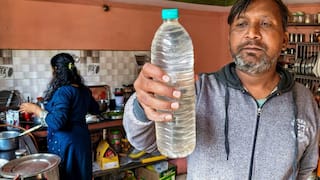Opinion: Kashi Vishwanath Corridor To River Cruise — How Varanasi Has Changed In 10 Years Of Modi Rule

Prime Minister Narendra Modi on Sunday laid the foundation stone for projects worth Rs 2,870 crore — including a sports stadium, and a new terminal building for Lal Bahadur Shastri International Airport — in his parliamentary constituency Varanasi.
Varanasi is a living example of how comprehensive changes can be brought about in a city. PM Modi became MP from Kashi for the first time in 2014. Over the years, the development work done by Modi as MP of Varanasi has become an example for others. More than 42 visits of the Prime Minister in the last 10 years have changed the face of Kashi. This city has gradually become the business hub of Purvanchal, with projects worth Rs 40,000 crore starting in Kashi.
ALSO READ | Opposition On the Rise & Fading ‘Modi Magic’ — Message From Haryana-J&K Exit Polls
Advanced Multi Modal Connectivity To Varanasi
From 15 until 2014, the number of flights to and from Varanasi has now reached 75. A 60-km long ring road has been constructed around Varanasi at a cost of more than Rs 5,000 crore to free the city from traffic jams. Soon, with the completion of the Varanasi-Ranchi-Kolkata Expressway, the distance and time between UP, Bihar, Jharkhand and West Bengal will be halved. The 18-kilometre-long Babatpur-Varanasi highway is today being called the ‘Gateway to Banaras’. The world's longest river cruise journey of 3,200 km, from Varanasi to Dibrugarh in Assam, has started, as has the country’s first International Water Transport Multi Modal Terminal on the banks of the river Ganga. Varanasi’s Diesel Locomotive Factory started manufacturing the world’s first 10,000-horsepower twin rail engine, converted from diesel to electric, in February 2019. Varanasi has become the first city in the country to start the construction of a public transport ropeway system. A city command and control centre has been built, from where the city is monitored through 4,500 CCTV cameras installed across Kashi.
Focus On Roots Of Kashi
A new dimension has been given to the development of the city by enhancing the grandeur of the many temples and ghats of Kashi. Earlier, devotees had to face a lot of problems for darshan in the street city of Banaras, but this has been solved by Prime Minister Narendra Modi through the construction of the Kashi Vishwanath Corridor. Eight new temporary ghats have been selected from Assi Ghat to Rajghat that will be fully developed. There are a total of 84 ancient ghats in Varanasi. With the construction of Namo Ghat, this has increased to 85. The eight new ghats will take the total number to 93. Meanwhile, tourism facilities are being developed in Sarnath.
ALSO READ | How Shocking — And Silent — Saffron Wave In Haryana Gives BJP A Boost Down South Too
More Tourists In Kashi Than In Goa
Shri Kashi Vishwanath Dham has changed the economy of Varanasi. Not only have employment opportunities increased, but there has also been an unprecedented increase in the number of tourists. Due to the dham, the total revenue of Varanasi has increased by 65%. According to statistics, 7.11 crore domestic and 83,741 foreign tourists arrived in Varanasi in 2022, which is a record. The number of tourists has increased almost 20 times as compared to 2014. Within a year of the inauguration of the dham, devotees have donated more than Rs 100 crore. Today, there are more than 1,000 registered hotels in Banaras. Apart from this, there are dharamshalas and guest houses. In the last one year, hotel rooms have not remained vacant even during the off-season. In fact, the number of tourists in Kashi is 8 times more than Goa’s annual average.
Over the last few years, along with PM Modi, former Japanese Prime Minister Shinzo Abe, French President Emmanuel Macron, German President Frank Walter and many other dignitaries have come to Kashi. Apart from this, the importance of Kashi has increased in the country and the world with the Pravasi Bharatiya Conference 2019, the Kashi-Tamil Sangamam 2023, as well as six meetings of the recently concluded G20 event.
Basic Infrastructure Gets A Boost
With the help of the Integrated Power Development Scheme, hanging electric wires have disappeared from Kashi — all of them moved underground. A 0.8-MW solar power plant has been established in the city. With the cooperation of Japan, the Rudraksh Convention Centre — with many small and big conference halls — has been built on 2.87 hectares of land. An integrated pack house has been built in the Karkhiyaon Industrial Area for the preservation of fruits and vegetables, while the country’s first international rice research centre has been established here with the help of the Philippines. The construction of a biogas-based power generation plant in Ramnagar is at the final stage. Lighting, toilets, changing rooms, police posts and tourist convenience centres have been built at all major ghats. The dairy industry in Banaras is getting a boost through Amul Milk, and, under this project, new milk markets will be built in more than 1,000 villages of Varanasi, Jaunpur, Chandauli, Ghazipur and Azamgarh districts.
Meanwhile, the Deendayal Handicraft Complex has been built on 7.93 acres at a cost of Rs 1,000 crore. It has a shopping complex, conference room, and museum. The Madan Mohan Malviya Cancer Centre has been started at a cost of Rs Rs 1,171 crore. A centre of the National Institute of Fashion Technology (NIFT) will be started soon to promote the textile sector. Apart from this, 102 cow shelter centres will be opened in Kashi for the protection and shelter of cows. An agricultural produce warehouse with a capacity of 100 metric tonnes ,and a multi-purpose seed store, have been established for the farmers here. The sewage treatment [lant (STP) has rid the city of the waste generated on a large scale.
Some Problems Remain
Even after so much development work, some problems remain unresolved. The entire business of Banarasi sarees is in the grips of a huge recession. It is important to change the situation, because the migration of weavers is not stopping, and the young generation does not want to take up the craft. The real identity of the Banarasi saree is not power loom but handloom, and handloom sarees are gradually being discontinued. It is very important to bring them back, this is the identity of Banaras and the economy of Varanasi is largely dependent on the Banarasi saree business.
Another area that needs attention is traffic. While a lot of arrangements have been made for traffic facilities in Banaras, there is still congestion, due to the increased tourist footfall. In light of this, the need for a monorail, and flyovers at many places, is being felt strongly. Also, to stop the exodus of talent, there is a need to establish MNCs in Purvanchal.
PM Modi's attachment to Banaras is well known. Recently, he said that, over the past 10 years, Banaras has made him a “Banarasi”. That’s why Banaras hopes that these problems will also end in the coming five years.
Kamalesh Kumar Tiwari is Head of History Department at Government Girls Degree College, DLW, Varanasi.
[Disclaimer: The opinions, beliefs, and views expressed by the various authors and forum participants on this website are personal and do not reflect the opinions, beliefs, and views of ABP News Network Pvt Ltd.]


























